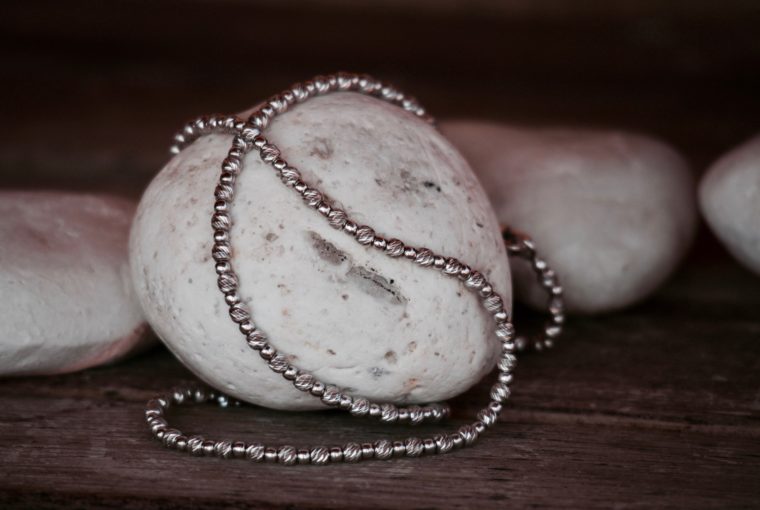White gold jewelry is elegant and has a unique luster. However, sometimes when wearing it, you may discover some discoloration. You can also see your white gold jewelry losing its color and turning yellow. If you know how to clean jewelry, then you didn’t cause the discoloration. So why does this happen? And, more importantly, can you prevent it? That’s for us to know and for you to find out in this article. Read further to find out how to maintain your white gold jewelry and even restore its beautiful look.
What is white gold jewelry?
As you probably know, you can’t find white gold in nature. This is color is man-made but, nevertheless, it remains an elegant and beautiful option for jewelry. In order to create white gold, jewelry makers mix yellow gold with palladium, manganese, and zinc. The final result of this alloy will have a silvery-white color but with an undertone of yellow. The intensity of the undertone depends on how much gold is in the alloy.
After the new metal is created, jewelry makers use a rhodium plating to remove the yellow tones. This is why when you shop for white gold jewelry you almost always find pieces with no yellow tinge. This is due to the rhodium plating.
White gold karat types
Just like with yellow gold, white gold also uses karats to measure the purity. The only difference is that, with white gold, you cannot have 22k because it wouldn’t be white anymore. As you know, 22k means 91.6% gold purity and, with that much gold in it, no alloy will ever get its white color.
This is why, when it comes to its purity, you will find white gold jewelry of one of the following karat types:
- 10k, which means that you have 41.7% gold in the alloy
- 14k that contains 58.3% pure gold
- 18k which has 75% gold
Why does white gold jewelry turn yellow?
The short answer lies in the rhodium plating. Most white gold jewelry pieces you find on the market today are dipped in rhodium to ensure their perfect white-silvery color. But this doesn’t mean they will forever maintain this color.
In fact, due to normal wear, the rhodium plating can wear off eventually. When you are able to see the yellow tinges, it means that the rhodium has worn off. Of course, you can try to wear your white gold jewelry less often but, in the end, chances are that it will still turn yellow. Don’t imagine that you buy a white gold jewelry piece and end up with a vividly yellow piece. As the rhodium plating wears off, your jewelry will still be whitish, but with yellow undertones.
Some people like this color as well, as long as it is uniform. But most people want to maintain their white gold jewelry’s original color, which leads us to the question: can you prevent your jewelry from turning yellow?
Preventing white gold jewelry from turning yellow
While there is nothing you can do to prevent this from happening, you can delay the process with a couple of useful tips.
The most important one is to keep your white gold jewelry away from water and chemical substances. Don’t swim, wash dishes or take a shower wearing your jewelry. Don’t put on perfume or body lotion while you still have your white gold jewelry on.
Another important thing to remember is that you shouldn’t polish your white gold jewelry too often. If you do that, you will end up removing the rhodium plating. Ideally, you will take it for a professional polishing once a year. While you can polish your silver and even gold jewelry at home, white gold requires a professional that knows how to polish it without removing the rhodium plating.
Can you restore white gold jewelry?
Yes, you can. In fact, it is very easy to restore a white gold jewelry piece that has turned yellow. You only have to find a jeweler that does replating and they will replate it with another rhodium layer. The price for this service will depend upon how worn off the original rhodium plating is.
Besides reasons that have a lot do to with how your jewelry looks, there is another reason why you shouldn’t delay replating your jewelry. After the rhodium plating wears off, your skin will come in contact with the white gold alloy. Very often, this alloy contains nickel and, if you have a nickel allergy, it will become impossible for you to wear your jewelry.
If you enjoyed reading this article, we invite you to discover more interesting facts about jewelry on our blog. Share this page with your friends so that they too can benefit from our jewelry knowledge. Visit Ana Luisa online jewelry shop to see our unique fine jewelry collections.

Others interesting posts about this topic :
- Everything You Need to Know about Jewelry Repairs
- How to Care for Vermeil Jewelry
- How to Clean Rhodium Plated Jewelry
- How to Care for Gold Dipped Jewelry
- How to Organize Your Jewelry Box
- How to Care for Jade Jewelry
- Yellow Pearls – Is it normal?
- What is a jewelry appraisal and why do you need it?
- Travel jewelry & what to take with you on holiday
- How often should you have a jewelry inspection?
- How to clean onyx jewelry
- How to clean white gold jewelry
- How to Clean Gemstones – Care Guide Part II
- How to Clean Gemstones – Care Guide Part I
- Brass Jewelry Care & Interesting Facts
- How to clean and care for gold plated jewelry?

